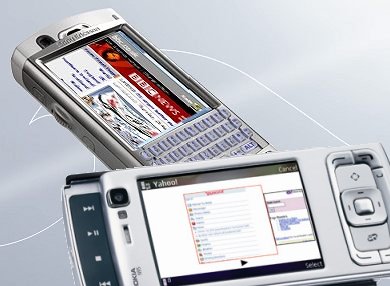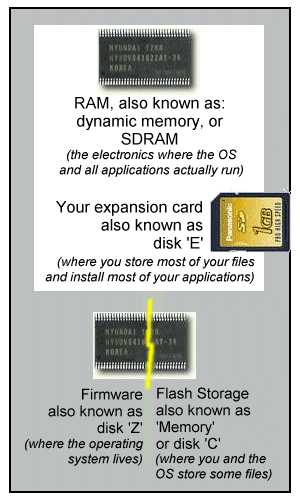
If you've owned a Nokia E70, N95 or N93, or a Sony Ericsson P990i, the chances are that, at some point, you've had a 'Memory' error, usually in the context of 'Low memory' or 'Out of memory'. Other Symbian OS models are vulnerable too, of course, but these devices have the worst track record. And it's easy to see why. The more powerful a device, the more memory is needed to accomplish the advanced functions and it soon runs out.
Memory = RAM
 But wait. Just to be absolutely clear, when manufacturers like Nokia talk about publicly about 'memory', they usually mean the flash storage chips on which you can store files and install applications. RAM, or 'dynamic memory', is the physical chip in which the Symbian Operating System, S60 or UIQ, and all your programs actually run, do their business, and so on. And it's vital, absolutely vital, to be aware of your RAM and treat it carefully if you want to avoid running into problems later on. Over and over again, I see problems on AllAboutSymbian forums, to do with things falling over because of lack of 'memory', and in most cases the device is talking about RAM, not flash memory.
But wait. Just to be absolutely clear, when manufacturers like Nokia talk about publicly about 'memory', they usually mean the flash storage chips on which you can store files and install applications. RAM, or 'dynamic memory', is the physical chip in which the Symbian Operating System, S60 or UIQ, and all your programs actually run, do their business, and so on. And it's vital, absolutely vital, to be aware of your RAM and treat it carefully if you want to avoid running into problems later on. Over and over again, I see problems on AllAboutSymbian forums, to do with things falling over because of lack of 'memory', and in most cases the device is talking about RAM, not flash memory.
How to 'use' RAM
Now, there's probably not a lot you can do about the base memory configuration of your smartphone, it's as you bought it, complete with basic spec and operator branding (make a note to yourself to try and buy SIM-free next time, perhaps?) However, what you install and how you use the device also has a big effect. And it will help enormously if you understand the implications of using applications like Web, Gallery, Java, and so on. Here are the bullet points:
- Install NSysInfo and then restart your smartphone (on a S60 device) or look under 'Status' (on a UIQ 3 device) and establish how much RAM your device has immediately after booting up. The Nokia N93, N95 and E70 (mentioned above) should all have in the region of 20MB free, while the Sony Ericsson P990i should start with around 16MB free. If your device starts with substantially less than these figures then you should take notice of the points below!
- Be very wary of utilities that like to sit in the background, using up RAM. Examples include replacement desktops/front screens, animated screensavers, anti-virus utilities (which are not needed), photo uploaders and instant messaging systems. If any of these aren't essential then don't use them and if you have to use them then look to turn off any 'auto-start' option. Obvious examples are the photo tool ShoZu and S60's own 'Wireless keyboard' utility.
- Be aware that the single biggest RAM hog on any S60 or UIQ smartphone will be the web browser. In fact, it's fair to say that if you don't use web browsing, you're unlikely to hit any serious RAM problems on any smartphone.
With the modern fad for rendering web pages just as if on a desktop, the poor smartphone has got to do the same job as MISE or Firefox on the desktop but with a tenth the RAM. It's a wonder that web browsing in this way on a smartphone works at all. For example, opening up the Expansys web site (a very image heavy and somewhat bloated front page) in S60 3rd Edition Web requires a minimum of about 13MB. If you then start a browsing trail with other complex pages or even open up a pop-up browsing window, it's easy to see why the 20MB you started with (which itself is probably down to about 16MB by the time you get round to web browsing) just isn't enough.
The 'cure', such as it is on devices such as the Nokia N95 and Sony Ericsson P990i, is of course to ask less of the browser by using the mobile versions of sites where possible. Most mainstream social networking and news sites have mobile versions, with exactly the same content but with smaller images and less bloat, requiring a lot less RAM to render. See, for example, www.allaboutsymbian/mobile .
- Be a little wary of Java (J2ME 'midlets') applications. Yes, it's great that your favourite game is now available, and hey it's great that it also runs on your friends non-Symbian smartphone, but be aware that Java applications swallow up a minimum of 5MB of RAM before the application itself even thinks about doing something. And if the J2ME app happens to be Opera Mini then you can add another few Megabytes of RAM to the equation, but at least there you know you're plumping for some serious functionality.
- If you hit problems starting a memory hog of an application, try restarting your smartphone, to clear out RAM and restart the operating system. If you have to do this regularly though (more than once a week) then you've got a problem (see above for strategies).
Sometimes, after trying to start a memory hog and receiving an error, you can wait a few seconds and then try again and will be successful. What's happened is that the OS itself has spotted what you're trying to do and has closed down other running programs to make room.
- In the unlikely event of a major, unexplained problem, especially if you're seeing unusual communications (like your smartphone trying to go online all the time), then you might have rogue software ('malware') on your phone. Have you by any chance installed a 'cracked' game from a warez site? There's no need whatsoever to worry about Symbian (so-called) viruses, as they can't be installed silently and, even if you should install one, it can't do anything harmful, but it goes without saying that if you stray into the criminal world of illegally cracked software then you shouldn't be surprised that some applications are not what they seem and may cause you problems... if you've been stung in this way, maybe it's time for a cleanup, i.e. syncing your data, noting passwords, doing a master reset and then syncing back?
- Make absolutely sure you keep up to date with firmware updates from your operator (if you have a network-locked device) or the manufacturer (if you bought it SIM-free). Nokia and Sony Ericsson both operate DIY firmware updates through your PC these days. Later is usually better, with more free RAM after booting and more efficient use of RAM afterwards. And, in addition, all sorts of under-the-hood bugs are likely to have been fixed.
- Start saving up for a model with more RAM! For example, the Nokia N95 8GB or the Sony Ericsson P1i. 8-)
A silver lining?
As with most things in life though, it's also useful to stop and consider silver linings in every cloud. OK, so your smartphone may be a little challenged in the RAM department but, as I say above, as long as you stay away from complicated web pages you'll be alright most of the time, with the OS taking care of unloading applications when needed. And, most of all, the limit on RAM means that you're not tempted to have (e.g.) 16 applications all running at the same time - several of these will probably be Java, games or Web itself and, trust me, even with Symbian OS at the helm, the sheer clamour for system events means that something's going to break sooner or later.
For example, I've had plenty of experience of unlimited RAM on the Nokia E90. There's around 80MB available after booting and I set about using every feature of the device without considering RAM or closing anything down with an 'Exit' key. A day or two later and I'm down to 50MB free, with anything up to 15 or even 20 applications running in the background and then something freezes or the E90 reboots itself. As I've said in the past, a modern OS is now so complex that it can't be perfect, and a few badly behaved third party applications don't help matters.
So, the silver lining in having low-ish RAM, if you want to see it, and (as they said in "Friends") you really have to want to see it, is that it's unlikely your stack of running applications will ever get to the point where things topple over - the OS is managing what stays running out of necessity.
Steve Litchfield, AllAboutSymbian, 5 October 2007
